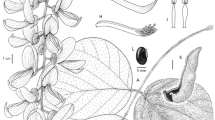Summary
The monospecific genus Steinbachiella Harms is reinstated as a distinct genus in Leguminosae, tribe Dalbergieae, based on recent collections from Bolivia. The fruits are samaras similar in appearance to those of the related genus Machaerium Pers. A combined morphological and molecular phylogenetic analysis suggests that the distally winged fruit of Steinbachiella and most Machaerium species is homologous. Nevertheless, Steinbachiella is distinct in having a unique suite of morphological characters that includes flowers in 1– 4-flowered racemes, the corollas yellow and totally glabrous, the standard petal with a deeply emarginate apex, long-stipitate ovaries and a samaroid fruit. In addition, in molecular analyses the genus is placed as sister to Machaerium and not nested within it.





Similar content being viewed by others
References
Harms, H. (1928). Steinbachiella, Leguminosae, in Plantae Steinbachianae III. Notizbl. Bot. Gart. Berlin. Dahlem 10: 345.
Jacquin, N. J. von (1760). Enumeratio systematica plantarum. Apud T. Haak, Lugduni Batavorum.
Klitgaard, B. B. & Lavin, M. (2005). Tribe Dalbergieae sens. lat. In: G. Lewis, B. Schrire, B. Mackinder & M. Lock (eds), Legumes of the World, pp. 307 – 335. Royal Botanic Gardens, Kew.
Lavin, M. (1987). A cladistic analysis of the tribe Robinieae (Papilionoideae, Leguminosae). In: C. H. Stirton (ed.), Advances in Legume Systematics, part 3: 31 – 64. Royal Botanic Gardens, Kew.
____, Pennington, R. T., Klitgaard, B. B., Sprent, J. I., de Lima, H. C. & Gasson, P. E. (2001). The dalbergioid legumes (Fabaceae): delimitation of a pantropical monophyletic clade. Amer. J. Bot. 88 (3): 503 – 533.
Lewis, G., Schrire, B., Mackinder, B. & Lock, M. (2005). Legumes of the World, Royal Botanic Gardens, Kew.
Polhill, R. M. & Sousa, M. (1981). Tribe 7. Robinieae (Benth.) Hutch. In: R. M. Polhill & P. H. Raven (eds), Advances in Legume Systematics, part 1: 283 – 288. Royal Botanic Gardens, Kew.
Ribeiro, R. A., Lavin, M., Lemos Filho, J. P., Mendonça Filho, C. V., Santos, F. R. & Lovato, M. B. (2007). The genus Machaerium (Leguminosae) is more closely related to Aeschynomene sect. Ochopodium than to Dalbergia: relationships inferred from combined sequence data. Syst. Bot. 32: 762 – 771.
Rudd, V. E. (1972). New taxa and combinations in Machaerium (Leguminosae). II. Phytologia 24: 121 – 125.
Stirton, C. H. (1981). Petal Sculpturing in Papilionoid Legumes. In: R. M. Polhill & P. H. Raven (eds), Advances in Legume Systematics, part 2: 771 – 788. Royal Botanic Gardens, Kew.
Acknowledgements
JW would like to thank various botanists, who accompanied him in the field when searching for Steinbachiella and, in particular, Daniel Soto who was with him when the original flowering material was found. Financial support of the Darwin Initiative 16–004 is gratefully acknowledged for the fieldwork on which this paper is based. We also thank Margaret Tebbs who prepared the elegant line drawing in Fig. 3 and two anonymous reviewers for their constructive comments.
Author information
Authors and Affiliations
Corresponding author
Rights and permissions
About this article
Cite this article
Lewis, G.P., Wood, J.R.I. & Lavin, M. Steinbachiella (Leguminosae: Papilionoideae: Dalbergieae), endemic to Bolivia, is reinstated as an accepted genus. Kew Bull 67, 789–796 (2012). https://doi.org/10.1007/s12225-012-9415-z
Accepted:
Published:
Issue Date:
DOI: https://doi.org/10.1007/s12225-012-9415-z




